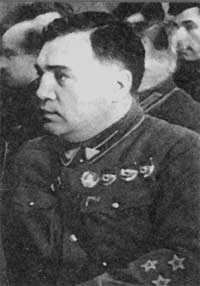Mikhail Frinovsky
| Mikhail Petrovich Frinovsky | |
|---|---|
 Mikhail Frinovsky | |
| Born | January 1898 |
| Died |
February 4, 1940 Moscow |
| Allegiance |
|
| Service/branch | NKVD |
| Rank | Komandarm 1st class |
Mikhail Petrovich Frinovsky (Russian: Михаил Петрович Фриновский) (January 1898 - February 4, 1940) served as a deputy head of the NKVD in the years of the Great Purge and, along with Nikolai Yezhov was responsible for setting in motion the Great Purge.
Biography
Mikhail Petrovich Frinovsky was born in 1898 to a teacher[1] in the village of Narovchat, Penza Guberniya. Prior to World War I, he studied in a religious school. In January 1916, Frinovsky volunteered for the army. He served as a sergeant in the cavalry until his desertion in August of the same year.[1] He joined an anarchist group and took part in the assassination of Major-General M. A Bem in 1917.[1]
In March 1917, Frinovsky began working as an accountant in Moscow. In September, he volunteered for the Red Guard. The unit under his command participated in the storming of the Kremlin, during which Frinovsky was severely wounded.
Between March and July 1918, Frinovsky again returned to civilian life and worked as a deputy administrator of the Hodynskaya Clinic. In July 1918, he joined the RKP(b) and volunteered for the Red Army. Frinovsky was made a commissar of a combat unit and also head of the Special Section (the political supervisor and the representative of the secret police, ChK) of the 1st Cavalry Army.
In 1919, Frinovsky was transferred to the VChK. Later in the year, he became a deputy of the Special Section for the Moscow ChK. In this capacity, he participated in many operations most vital for the survival of the bolshevik regime, including actions against the anarchists, as well as the destruction of anarchist and rebel militias in the Ukraine.
From December 1919 until April 1920, Frinovsky served in the Special Section for the Southern Front. In 1920, he was transferred to the South-Western Front, where he served as chief of the Special Section, and as deputy to the Chief of the Special Section of the 1st Cavalry Army. Between 1921-1922, he was the deputy to the Chief of the Ukrainian ChK.
From 1922 to 1923, Frinovsky headed the administrative division of the Kiev GPU. From the June 23 he was also head of the OGPU of the South-East.
In November 1923, Mikhail Frinovsky was transferred to the Northern Caucasus and given command of the Special Section for the region. In January 1926, he became head of GPU forces.
In July 1927, Frinovsky was again transferred to Moscow, this time as aide to the commander of the Special Section for the region. In 1927, he completed high-command courses at the Frunze Military Academy. From November 28, 1928 until September 1, 1930, he served as the commissar of the Special Forces division assigned to the Dzerjinsky College of the OGPU USSR.
On September 1, 1930, Mikhail Frinovsky was promoted and made chairman of the GPU of Azerbaijan.[2] In April 1933, he was again promoted and became the commander of OGPU Border Guard. On July 10, 1934, Frinovsky became head of Border and Internal Security for the NKVD.
After the fall of Genrikh Yagoda and the appointment of Yezhov to that post, Frinovsky became deputy of the Narkom of Internal Affairs.
Great Purges
From April 15, 1937 to June 9, 1938, Frinovsky was head of State Security. From March 28, he was also head of the State Security of the NKVD. From 1937, Mikhail Frinovsky was a member of the Supreme Soviet of the USSR. During this period, he became a close ally of Yezhov and along with him was responsible for organizing the repressions which began that year. Frinovsky personally, without the authorization of a judge, signed numerous arrest warrants.
On September 8, 1938, Frinovsky was made the People’s Commissar of the Navy. This was a well known method of Stalin to ensure successful liquidation of a mighty rival, which also served to weaken Yezhov considerably. By this appointment, Frinovsky was uprooted from his devotees and the sources of power, being forced to travel to distant locations and being ever surrounded by unfamiliar people of unknown loyalties.
On April 6, 1939, Mikhail Frinovsky was arrested. He was accused of “participating in conspiracies within the NKVD” and on February 4 of the following year, along with Yezhov he was sentenced to death and executed in Moscow.
References
- ↑ 1.0 1.1 1.2 Rayfield, Donald (2007). Stalin and His Hangmen. Random House Digital, Inc. p. 86. ISBN 0307431835. Retrieved February 8, 2013.
- ↑ "Heads of special services of Azerbaijan". Ministry of National Security of Azerbaijan. Retrieved February 8, 2013.
| Military offices | ||
|---|---|---|
| Preceded by Pyotr Alexandrovich Smirnov |
People's Comissar of the Soviet Navy, Commander-in-Chief of the Naval Forces 1938-1939 |
Succeeded by Nikolai Gerasimovich Kuznetsov |